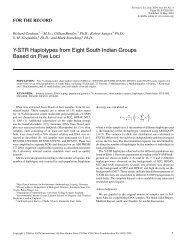MEMES Robert Aunger LSHTM 'Meme' is a ... - Hygiene Central
MEMES Robert Aunger LSHTM 'Meme' is a ... - Hygiene Central
MEMES Robert Aunger LSHTM 'Meme' is a ... - Hygiene Central
Create successful ePaper yourself
Turn your PDF publications into a flip-book with our unique Google optimized e-Paper software.
most psycholog<strong>is</strong>ts, imitation involves observation of a behavioural model – a figure<br />
conspicuously absent when reading a text.<br />
Further, involving artefacts like books in social learning creates problems for the notion of<br />
inheritance. A typical story about meme replication through artefacts would be as follows (see<br />
e.g., Dennett 1991 or Blackmore 1999 for stories of th<strong>is</strong> type): Ms. X creates a new innovation,<br />
a wadjet. Mr. Y comes along and, simply by observing the wadjet in operation, infers its<br />
function and recreates a copy of the device, even though Mr. Y has never met or spoken to Ms.<br />
X. The wadjet idea or meme has been recreated in the mind of Mr. Y from information<br />
contained solely in a sample wadjet. Mr. Y can even build a second wadjet through a process<br />
of reverse engineering, based on inferred knowledge from the sample wadjet.<br />
Th<strong>is</strong> story implies an evolutionary lineage of events as follows: Ms. X wadjet Mr. Y <br />
wadjet. Crucially, the story depends on memes passing from one person to the next through an<br />
artefact: in effect, memes must ex<strong>is</strong>t in artefacts. However, artefacts do not contain<br />
representations of themselves; instead, human minds construct such representations based on<br />
signals of the form and function of said artefacts (D<strong>is</strong>tin 2004). Nothing in the form or action of<br />
an artefact expresses its function. The fact that a wheel rolls along (when pushed on its side)<br />
does not tell the world that its function <strong>is</strong> transportation. Artefacts, of themselves, belong to a<br />
dead physical world without meaning. Determining functionality <strong>is</strong> an act of interpretation by an<br />
appropriately prepared mind, depending on prior experience and knowledge about the general<br />
category to which an artefact belongs. But without knowledge of function, it <strong>is</strong> impossible to<br />
determine which features are crucial and which are incidental, when attempting to copy the<br />
artefact. For example, Mr. Y could make a wadjet out of wood, but it might not do the job for<br />
which wadjets were intended. If a copy of an artefact such as a wadjet <strong>is</strong> successfully made, it<br />
<strong>is</strong> thanks to the fact that Mr. Y has brought specialized knowledge to the situation (such as the<br />
fact that wadgets need to be made of materials with significant tensile strength like metal),<br />
rather than having acquired that knowledge from the object under study. The wadjet-making<br />
information does not derive from Ms. X, nor from instructions symbolically embedded in the<br />
wadjet; rather, it originates with Mr. Y, thus violating the principle quality of replication being<br />
d<strong>is</strong>cussed: information inheritance (D<strong>is</strong>tin 2004). Reverse engineering owes more to the skill<br />
and knowledge of the engineer than to the information contained in the wadget. Crucially, the<br />
information that makes one wadjet similar to another <strong>is</strong> based in the engineer’s concept of what<br />
a wadjet <strong>is</strong>; the artefact itself has no sense of identity.<br />
Of course a ‘wadjet construction manual’ could be written, but that would be a separate<br />
artefact, not a wadjet. In the case of other acknowledged replicators – genes, prions and<br />
computer viruses – the information that makes the copy similar to the source comes directly<br />
from the source: DNA uncoils to expose one strand so that its complement can be created; a<br />
protein unfolds to be reshaped into the form that makes it a prion (proteins that convert normal<br />
proteins into copies of themselves merely through contact); computer memory reg<strong>is</strong>ters are<br />
flipped on the instructions of a computer virus. A similar model would have artefacts playing an<br />
equally active role in instructing people how to make them. But there <strong>is</strong> nothing intrinsic to an<br />
artefact that provides such knowledge. Instead, Mr. Y must bring th<strong>is</strong> knowledge to the<br />
duplication process -- or infer it using background knowledge he already possesses about how<br />
the world works. Even a ‘wadjet construction manual’ would tell Mr. Y nothing about where to<br />
find the components, much less how to make them, nor which tools he might need, nor where<br />
to find them, nor in which manner to hit component A so that it fits into a slot on component B.<br />
Now imagine the manual <strong>is</strong> written in a language Mr. Y doesn’t understand! All of th<strong>is</strong> crucial<br />
information <strong>is</strong> implicit and must be supplied – in highly variant ways – by the wadjet-maker. So




